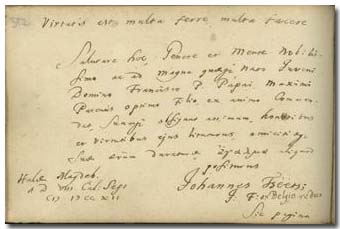
Virtutis est multa ferre, multa facere
Salutare hoc Genere et Mente nobilissimo ac ad
magna quaeque nato Juveni Domino Francisco P.
Pápai maximi Parentis optimo Filio, ex animo
Commendat, Suumque obsignat animum, honoribus
et virtutibus ejus litaturus, amicitiaeque suae aevum

Johannes Tséétsi J[ohannis] F[ilius] ex Belgio redux
Halae Magdeb.

Sic pagina [continued
on the next page:]
jungit amicos |
|
It is a matter of virtue to endure and to accomplish a lot.
With this I want to greet from the deepest of
my heart the young Ferenc Pápai Páriz, noble by birth and by
spirit, and born for accomplish great things, a worthy son of his
great father; at the same time giving a token of my devotion,
offering a sacrifice to his merits and virtues, and erecting a
perennial monument to my friendship.
János Csécsi, son of János
returning from Belgium
In Halle of Magdeburg, on the 8th day before
the calends of September of 1712.
[at the bottom of the page, written
through the two pages:] Thus pages unite friends.
|
p. 352. Halle, August 25, 1712
Csécsi, János
(1689-1769), Reformed teacher and
writer
János
Csécsi (Tsétsi) was born in Gönc (Abaúj county) on June 11, 1689,
the son of the Sárospatak teacher János Csécsi (1650-1708) and of
Klára Rajczy. He learned in Kassa (Košice) and Sárospatak, in the
latter place he was a teacher in 1707. From 1709 he went to visit
foreign academies. He attended philosophy and theology in 1710 in
Utrecht and in 1711-12 in Franeker, he visited England, Italy,
France and Switzerland. From 1712 he lived in Sárospatak, where he
became the successor of his father. He taught Greek, history,
church history, Cartesian philosophy, mathematics, physics and
astronomy. He came into conflict with two colleagues and the local
pastor, and this constant hostility led to grave clashes between
the two parties of the school. In 1723-25 an investigating
committee was sent out, and finally in 1734 he and a colleague of
him were dismissed from the school. After this le lived a lonely
life in Sárospatak until his death in June 1, 1769. A part of his
works remained in manuscript. His geography published in the
translation of István Vécsei Pataki (?-1743) is the first
geographical work published in Hungarian. Some of his other works:
Oratio de maximo huius seculi vitio, calumnia, habita occasione
examinis publici a Johannes Tseetsi j[un]. Lőcse, 1719. –
Aphorismi, in quibus antiquitates veterum Hebraeorum brevissime
exhibentur. Bern 1726 –
Oratio secularis altero reformationis jubilaeo habita in auditorio
… athenei Patakiensis ad diem XXXI. octob. 1717. Zürich,
1720. – Vetsei P. István magyar geografiája, az az ez egész
világ négy részeinek … rövid le-irása. Melly … még
1741-ben Pétsen irattatott vólt … Nagykároly, 1757. – Ifjabb
Tsétsi János Havi Krónikája a Rákóczi-háború történeteiről
1703-1709. Közli Thaly Kálmán, Monumenta Hung. Hist.,
Scriptores 27, 1875. (in Latin).
As it is attested by his note, at the end of August of 1712 Csécsi
was in Halle, on his way returning home from Belgium. His father,
János Csécsi Sen., as well as Sámuel Kaposi Juhász who also wrote
in the album (p. 11) both had been
correctors in the 1680s of the renowned Hungarian Bible of Miklós
Misztótfalusi Kis published in Amsterdam. – At that time the
northern part of the Netherlands was also referred to as "Belgium".
•
AlbUtr 111 • MÉL • MNL • Pallas • Szinnyei • ÚMÉL • ÚMIL •
Zoványi-Ladányi |

